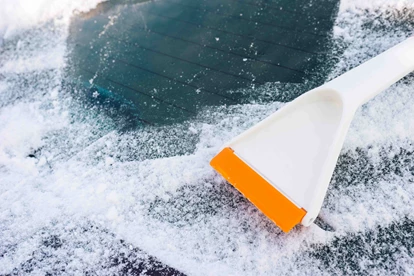
Winter in the UK brings colder temperatures, slippery roads, and challenging driving conditions. From frosty mornings to snow and ice, preparing your car for winter driving is crucial to ensure your safety and the safety of others on the road. In this article, we’ll provide a comprehensive guide to winter car preparation, covering essential maintenance, safety checks, and practical tips for driving in cold weather.

What should you keep in your car?
Here is a list of the essential things that you should keep in your car. It's always worth keeping a bag in the car with the essential stuff that can be used all year around.
When it comes to winter you may want to add a few extra items. Hopefully you will never need them but being prepared is better than not, especially when breakdown services can take hours to reach you on busy days. So having a few essentials will make the wait a little more comfortable

Driving Tips for winter driving.
In the winter the roads could be icy or even covered in snow.
Before setting off make sure you do the following.
- Your car is fully de-iced and any excess snow is removed.
- Check your lights are working correctly.
- Clear your number plates and make sure they are visible.
- Make sure your windscreen wipers are not stuck to the windscreen and your washer fluid is topped up.
- Demist your windscreen and windows. Use your Air con to do this if you have it.
When driving
- Where possible try to stick to main roads that have been gritted.
- Drive smoothly with slow acceleration, braking and steering.
- Keep at least double the distance from the car in front as stopping distances are far greater in wet and icy weather.
- Stay in a higher gear and pull off in second or with some automatics select winter mode.
- Keep your speed down
- When approaching junctions and roundabouts start slowing much sooner and be prepared to stop before the junction.

Planning your Trip
Before setting off in bad weather ask yourself do you really need to make the journey?
If you do, plan your trip and keep to main roads as much as possible as they are more likely to be kept open and have salt on them.
Although on some days it maybe sunny, some areas of roads could still be icy and you can’t see black ice so drive with care.
Before setting off check your car:
- Check that all your lights are working and that the glass is clean.
- If you have snow on the car, make sure you remove it all off, including the roof as it can slide down and obscure your visibility or fly off and become a hazard.
- Check your tyre pressures.
- Check your tread depth, the minimum legal limit is 1.6mm across three quarters of the tyre but you should really change them way before this especially in winter.
- Check windscreen wipers, make sure they clear the windscreen without smearing and that there are no cuts or splits in them.
- Make sure your windscreen washer bottle is full and has the correct level of screen wash.
- Always make sure you have plenty of fuel, fill your car up more regularly and don't let it get too low.
Preparing your car for Winter.
1. Check and Change Your Tyres
Tyres are the most critical element of your vehicle’s contact with the road, and their performance can dramatically affect your safety in winter conditions.
-
Switch to Winter Tyres: In regions where temperatures regularly drop below 7°C, winter tyres are a good investment. These tyres are made from softer rubber compounds that provide better traction in cold weather, and their deeper tread patterns help grip snowy and icy roads more effectively.
-
All-Season Tyres: If you live in an area with mild winters, all-season tyres might be sufficient, but it’s essential to regularly check the tread depth. UK law requires a minimum tread depth of 1.6mm, but in winter conditions, a tread depth of at least 3mm is recommended for optimal grip on wet, icy, or snowy surfaces.
-
Check Tyre Pressure: Cold weather can cause tyre pressure to drop, which reduces grip and increases the likelihood of skidding. Check your tyre pressure regularly (preferably every week) and ensure it matches the manufacturer’s recommended levels, usually found in your car manual or on the driver’s side door frame.
2. Inspect and Top Up Your Fluids
During winter, the fluids in your vehicle play a crucial role in ensuring smooth and safe operation.
-
Antifreeze: Antifreeze, also known as engine coolant, helps regulate your engine’s temperature and prevents it from freezing in cold weather. Check your coolant levels and ensure the mixture is correct—most experts recommend a 50/50 blend of water and antifreeze. You can test the mixture using a hydrometer or ask your mechanic to do it for you.
-
Windscreen Washer Fluid: Normal water won’t cut it in freezing conditions, as it can freeze in the washer reservoir or on your windscreen. Use a washer fluid with antifreeze properties, which will help keep your windscreen clear of snow, frost, and salt residue.
-
Oil Levels: Cold weather can make engine oil thicker, which can affect the way your engine runs. Check your oil levels and consider switching to a winter-grade oil if your area experiences prolonged sub-zero temperatures.
3. Prepare Your Windscreen and Wipers
Your visibility is essential for safe driving in winter conditions, and that starts with maintaining your windscreen and wipers.
-
Inspect Wiper Blades: Wiper blades can become worn and less effective at clearing snow, ice, and water from your windscreen. Consider replacing them with winter wiper blades, which are designed to remain flexible in freezing conditions and handle heavy snow.
-
De-ice and Defrost: Use an effective de-icer spray or an ice scraper to clear your windscreen, windows, and mirrors of ice before you drive. Never use boiling water to defrost your windscreen, as it can crack the glass due to sudden temperature changes. Also, make sure your car’s defroster is working properly to prevent your windscreen from fogging up while driving.
-
Windscreen Chips: A small chip in your windscreen can quickly turn into a crack in cold weather. Temperature fluctuations cause the glass to expand and contract, which can worsen existing damage. Repair chips before winter arrives to avoid the risk of needing a full windscreen replacement.
4. Check Your Lights
During winter, you’ll be driving in darker conditions, and good visibility is vital for both you and other road users.
-
Inspect Headlights, Tail lights, and Indicators: Make sure all lights are working properly and replace any bulbs that are dim or burnt out. Regularly clean your headlights and tail lights, as they can become coated in grime, salt, and dirt from wet winter roads.
-
Upgrade to LED or Xenon Bulbs: Consider upgrading your headlights to brighter, more efficient LED or Xenon bulbs. These lights provide better illumination in foggy or dark conditions, making it easier to see and be seen on the road.
5. Check Your Brakes
In winter, road surfaces are often icy, wet, or covered in snow, making braking distances longer. Ensuring your brakes are in top condition is critical to your safety.
-
Inspect Brake Pads and Discs: Have a professional check your brake pads and discs for wear. Worn brake components will reduce braking efficiency, which is dangerous in slippery conditions. If you notice any unusual sounds or feel a vibration when braking, get them inspected immediately.
-
Brake Fluid: Check the brake fluid level regularly and top it up as needed. Low brake fluid levels can affect the responsiveness of your brakes, which is particularly dangerous in winter driving conditions.
6. Prepare for Black Ice and Slippery Roads
Winter driving brings the added hazard of black ice, an invisible and extremely slippery layer of ice on the road.
-
Drive Cautiously on Icy Roads: When driving in icy conditions, reduce your speed and leave extra distance between you and the car in front. It takes much longer to stop on ice than on dry pavement.
-
Approaching a junction : When approaching a junction prepare to stop earlier than you would normally do, so if there is ice you will still have time to stop.
7. Consider Breakdown Cover
Breakdowns are more common in winter due to cold weather affecting vehicle performance. Having adequate breakdown cover ensures that help is available if you run into trouble on the road.
-
Winter-Specific Cover: Some breakdown cover providers offer winter-specific options that include benefits such as priority assistance during cold weather, vehicle recovery, and free callouts. This can provide peace of mind if you regularly drive in areas prone to snow or extreme cold.
-
Battery Assistance: Many breakdown services offer assistance for dead batteries, which is one of the most common issues during winter months. Ensure your policy includes this service to avoid being stranded.
Preparing your car for winter driving in the UK requires more than just being ready for snow. From checking your tyres and fluids to ensuring you have the right emergency equipment, taking a proactive approach to car maintenance will help keep you safe on the road during the cold months.
By following these winter driving safety tips, you can reduce the risks associated with winter weather and ensure that your car is equipped to handle whatever the season throws at it.
